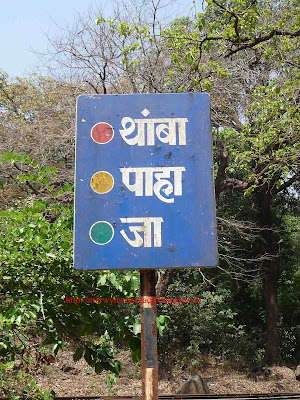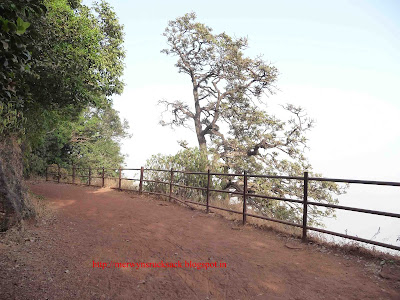The last time I visited Kaldurg fort, I could not reach the top.
To read about Unconquered Kaldurg Fort Trek in Palghar
What a shame! But someone has rightly said, “Try, try, till you succeed!” I therefore decided to make yet another attempt to climb Kaldurg Fort.
This time I planned my trip with Aashish Chawla. I had met Aashish via my blog. He loves to read my posts and visit the places that I have visited.
We met a day before the trip to discuss the train timing and other details. We planned to board the 4.54 am train to Virar which lands at Virar at 5.50 am. This would give us enough time to board the Virar Dahanu shuttle at 6.15 am. In case we missed the 4.54 am train, we had a backup train to Virar at 4.58 am. These two trains are slow trains. I had told Aashish about the 5.20 am fast train to Virar which arrives at Virar at 6.10 am. But he put off the suggestion, saying that it would be a race against time to reach the Virar Dahanu Shuttle. If we missed this connecting train, we would have a long wait in store. The next train is after a gap of 1½ hours. So we decided to board the 4.54 am train.
I had told him that I had been to this fort before and that we had to discontinue the climb midway and so I had planned to do it again.
It appeared that things were not going to work out according to our plan. Read on to find out just how.
The next morning at 4.40 am, I was at the station near the ticket booking counter. I decided to call Aashish to confirm whether I should book the tickets. So I called him up. The phone rang and rang and then got disconnected. Had Aashish changed his mind about going on this trip? Why hadn’t he called me? I would not have woken up so early. I began to grumble to myself.
 |
| Kaldurg Fort in a Distance |
Within two minutes, Aashish called back to say that he had just woken up and that he would reach the station within 15 minutes. He told me to book the tickets. The only hitch was that we would end up missing the 4.54 and 4.58 am trains. Our only bet was the 5.20 am train, which we had decided against because of the little time it would afford us between disembarking from one train and boarding another.
Nevertheless, I bought the tickets at a cost of Rs 15 per head and waited eagerly on platform no 4 where the fast train was supposed to arrive. How the guy managed to do it, I do not know, but he showed up just as the train arrived, and we managed to board the train after all.
Now we were hoping that we didn’t miss our Virar Dahanu Shuttle at Virar.
Our train arrived at 6.05 am at Virar. Aashish got out and began to run towards the platform. I followed suit. We had a lot of running to do. It was a close call. Finally after a lot of running, we boarded a decidedly ‘fishy’ smelling train and managed to get ourselves a place to sit.
Only to find out that the train left at 6.20 am. I told Aashish that we were destined to board the fast train, to which he readily agreed.
Aashish is 48 years old but has the spirit of a teenager. He was very active and I was shocked that he started trekking just a year ago. It was a privilege to trek with him.
At 6.47 am, we landed at Palghar station. We managed to get morning tea and vada pav for breakfast and then started off to the share-a-rickshaw stand to board our ride to Wagoba Mandir on the way to Manor.
At 7 am, we were in the rickshaw, waiting for the rickshaw to be full so that we could have a head start. Finally after a 20-minute wait, the rickshaw was full. We were all cooped up like cattle, and the rickshaw driver was clearly bent on piling in more passengers than his vehicle could properly accommodate.
After a 20-minute ride in the congested rickshaw at a cost of Rs 15 per head, we were at the Wagoba Mandir.
Luckily there were few monkeys here; compared to the last time I was here. We wasted no time and decided to start with our trek.
 |
| Aashish and me up Kaldurg Fort |
It was 7.45 am on my watch. We started climbing. The climb is vertical. Aashish told me that he has been to at least 25 to 30 forts and never has the climb been so vertical at the initial stage.
But we managed to motivate ourselves and kept going, taking small two-minute breaks in between and finally reached the basalt rock plateau in a record breaking 50 minutes.
Aashish immediately assembled some stones to mark the place as everything looked similar here. Trekkers’ instincts, I should say.
The last time I came here, we had reached this spot in two hours time, because we had gone down the wrong path. But this time we decided to take only the road going upward, ignoring the other roads.
The rock patch offers a good view of the land, the water bodies, the curvy road leading to Manor from Palghar and the Fort of Kaldurg up on the hill.
Now we had another question in our minds. There was a small gap in the rock that led to the top. We were hoping that it would not be the way to the fort. It looked difficult from here. Imagine what it would be when we neared it?
But that did not stop us; we took a 30-minute break and started on the tricky journey upwards.
Walking on the narrow trails, mainly comprising loose mud, we finally reached the place where we had given up.
From there we followed the up-down, inside curve, outside curve, mud, stones and loose mud trail to the top of the fort and at 10 am we were at the top.
This is the highest point in Palghar. All the other hill ranges were far below this one.
 |
| View fo Palghar from Kaldurg Fort |
The feeling of accomplishing something that we couldn’t do is truly amazing. Its only after you fail once that you appreciate the true meaning of achievement.
Not much remains of this fort today. A wall comprising five stone bricks is all that can be called a fortification. The top part is made of huge rocks that appeared to us as the fortification from the basalt plateau. I guess the shape and the colour is what made us think of it as the wall.
We could locate three rectangular shaped cutouts in the rock. These are water tanks which had dried up. They were not too deep. There is no water supply on this fort. So if you are planning your trip in the summer, carry at least three litres of water.
Unfortunately, some ignorant fools had written their names all over the rock surfaces. Idiots. When will they learn?
This is actually a watchtower as it provides an amazing view of the land below. The water bodies nearby, the roads from Palghar to Manor and the factories in Palghar.
We sat on the rocks and ate Aashish's egg parathas, while enjoying the cool breeze.
Then it was time for the climb down. While the ascent was difficult, I realised that climb down would be even more treacherous. Somehow I am not too confident when it comes to walking on loose soil.
Aashish was there, supporting me and guiding me down the cliff as we started the descent at 10.30 am. We reached the basalt rock plateau at 11.20 and after taking a 15-minute break we were down at the temple at 12.20 pm. We had managed to climb up and down in four hours. Kudos to us.
At the temple we had a splash in the water from the hand pump. After refreshing ourselves, we saw an ST bus approaching. We signaled it to stop and boarded it and alighted at Palghar station. The fare of the ST bus is cheaper than the rickshaw, as it cost us just Rs 14 (for both).
The frequency of the ST bus is lesser than the rickshaw, so people commute more by rickshaw and travelling in that congested rickshaw is a pain. Travelling was so much fun in the empty bus.
 |
| Me atop the Fort |
After having our lunch, we were at the station waiting for our train which was scheduled at 2.45 pm. It was the Virar Dahanu Shuttle that was going to take us to Virar.
We killed time talking to fellow passengers. They could not believe that we had come to Palghar to see a fort. Then Aashish pointed out the fort to them. Why this fort, was their next question. Aashish told them that we love to do such stuff that involves breaking of hands and legs; it gives us great joy. Ha-ha
Finally the train arrived and we were at Virar and from there boarded a train to Andheri and from there - home.
We got everything right on this trek. We didn’t get lost on the hills; we boarded the train that we had planned to board, and everything went smoothly. The heat was not that strong to exhaust us so we managed to pull off this trek in half a day.
A big thank you to God who was with me on this trek.
Finally I can say that I have conquered Kaldurg with Aashish. Next in the line of fire is Mahuli. Why? Because it remains unconquered.














































